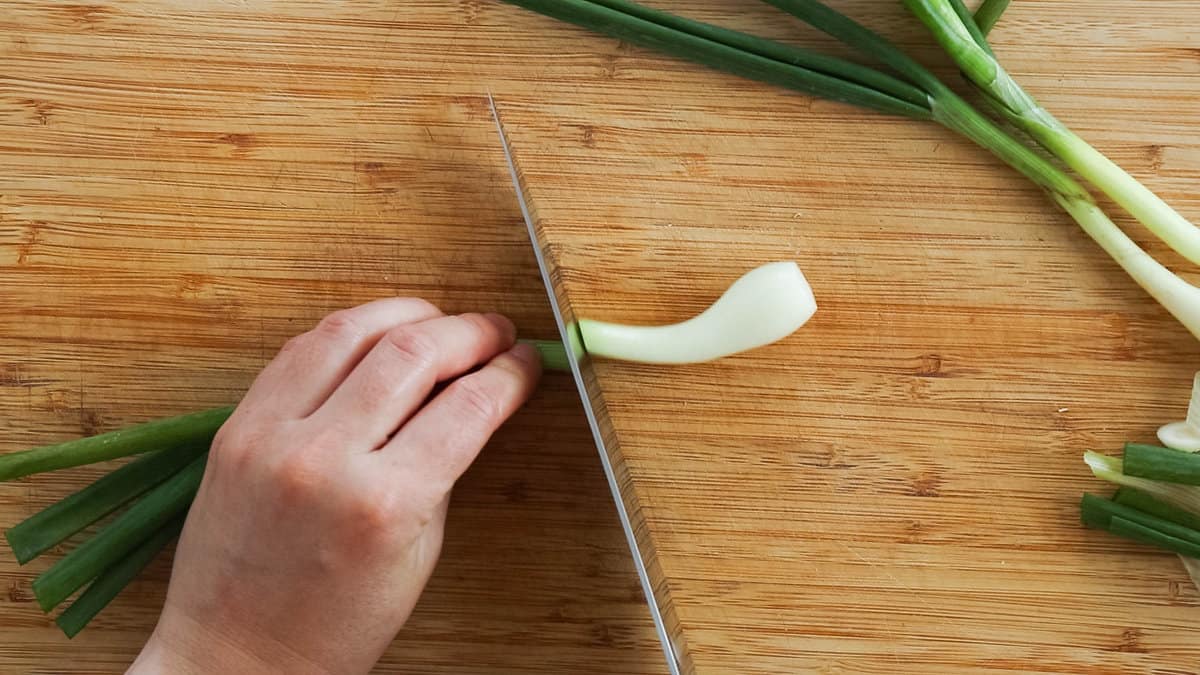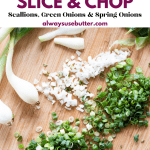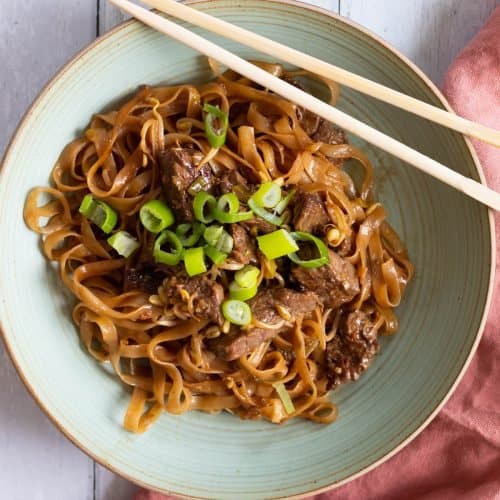Ever wondered about the right way to slice green onions? Then I have the guide for you! Follow the step-by-step pictures and video below to learn how best to slice and cut green onions, scallions, and spring onions.

A Great Flavor Boost + Garnish!
I use scallions, green onions and spring onions a lot in my cooking, and I love their sweet onion taste. It's sharp but not as sharp as that of other onions, and it adds a nice pop of color.
I often use it raw as a garnish, and otherwise add it just at the end of cooking - so I still get some of that nice bite. But you can also use it in place of any other onion, for a milder onion flavor, and let it simmer along with stews or soups for hours.
Are green onions, scallions, and spring onions the same?
The short answer is: yes, and no. Also: it depends on who you ask.
They are basically the same to begin with - meaning, they can all stem from the same onion varietals. And while the names are often used interchangeably, the general concensus seems to be that they differ in maturity.
Scallions are the youngest, and the bulb the smallest. Then come green onions, with a bit more of a bulb. And finally, spring onions - with an even more pronounced bulb.
For it to be a "true" spring onion, it should also be planted in fall, and harvested in spring (hence the name).
The taste is similar, with all of them having a mild onion flavor and, therefore, being great to use raw. However, scallions are milder than the other two, and true spring onions are much stronger in flavor than both green onions and scallions. In most cases, though, spring onions are just green onions with a different name.
The onions shown in the pictures in this post are green onions.
Which Part Do You Use?
You can - and should! - use both the white bulb and the green stalks of the green onion. Sometimes I will use the bulb and a bit of the stalk in the food while cooking, and save the green tops for sprinkling over the finished food.
How to Chop Them the Easy Way
1. Sharpen Your Knife
This step is not specific to chopping green onions - but it's important enough I want to mention it. Start with a sharp knife, and chopping anything at all will just be soo much easier. So start by sharpening your knife, and then grab a good chopping board and let's get started.
2. Clean & Peel
Start by rinsing your onions to remove any dirt on the outside. Then, cut off the very root end (with as little of the bulb as possible) and check to see how the outer layer of the onion looks. If it looks nice, leave it. But if it looks damaged, remove the outer layer first.
I also recommend cutting

2. Trim
I also recommend trimming the green part, as the final part is often damaged and/or dried. Just cut off as much as looks bad, and keep the rest.

3. Separate Green & White
Find where the white bulb starts turning into green stems, and make a cut. You will want to chop the green & white separately, especially if the bulb is larger.
If the bulb is small (think scallions) and you don't see a need to keep the green and white separate, you can skip this step.

4. Chop the Bulb
Start by chopping the bulb. Slice it lengthwise into matchsticks, but make sure to keep them together. Then slice across the matchsticks to get nice, small, pieces.

5. Slice the Greens
I prefer to keep the greens in slightly larger pieces. Either just slice it thin right away, or cut the stem in half and then slice it thin.

6. All Done!
And now you've got finely chopped green onions - separated into white and green. Either use both types in or on top of the food - or add the white to the food, and keep the green for garnishing.

What Do You Use Them For?
I love to use green onions for mainly 3 things:
- As a garnish on top of finished food
- In food, instead of other types of onion
- Raw in salads and salsa, for a nice share bite that's still not too overpowering
Below are some specific cases where they work exceptionally well!
Asian Food
While you can use them in all types of food, they're most common in Asian cooking, and often added to stir fries and ramen. Or to dishes like larb gai.
Instead of Chives
Generally, you can also use green onions for anything where you would otherwise use chives. The taste of green onion is similar but a bit more intense.
Instead of Shallots and Leeks
You can often use green onions instead of shallots, although shallots have a bit stronger taste. You can also use green onions instead of leeks.
What to Do with Leftovers
Green onions, as all onions, are best used fresh chopped. But if you did end up chopping too much, you can save the leftovers.
Storing: Store leftovers in the fridge in an airtight container for up to 5 days.
Freezing: Store leftovers in the freezer in an airtight container for up to 3 months.
Quick & Easy Recipes Using Green Onions
- Larb Gai (Spicy Thai Minced Chicken Salad)15 Minutes
- 20-minute Halloumi Pasta Primavera [Vegetarian]20 Minutes
- 20-minute Beef Chow Fun20 Minutes
- The Best Instant Pot Buffalo Chicken Dip40 Minutes
Recipe

How to Slice Green Onions
Print RateIngredients
- spring onions, scallions or green onions
Instructions
- Start by cutting off the root part of the white bulb, and the tops of the green stalks. Check to see if the outer layer of the onion is damaged or if it looks nice. If it doesn't look nice, peel it off and discard it.spring onions, scallions or green onions
- Cut to separate the white bulb from the green stalks.
- Chop the white bulb as you would an onion - first slicing lenghtwise, and then across the slices.
- Slice the stalks thin.
- Use in cooking or to top finished dishes. Enjoy!
Equipment (may contain affiliate links)
Video
Notes
Nutritional information is approximate and automatically calculated, and should only be viewed as an indication.











Comments
No Comments